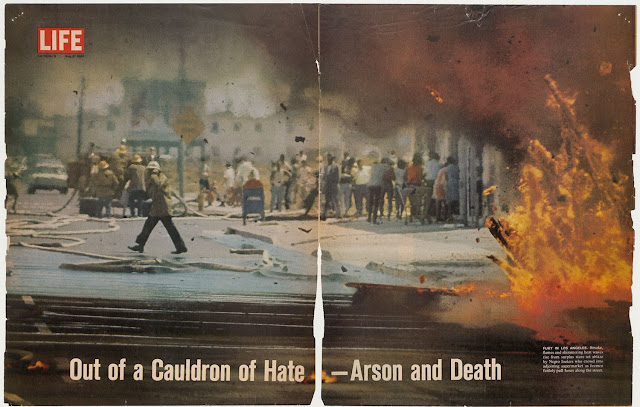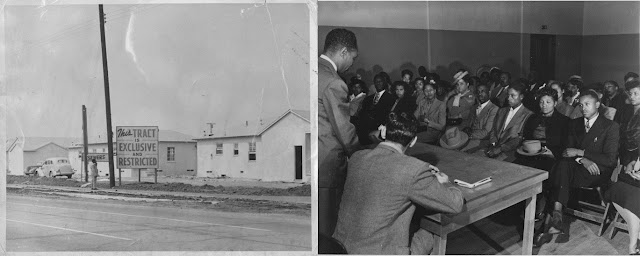 |
Arson and Street War, Life magazine, August 27, 1965
Courtesy California ephemera collection, UCLA
Library Special Collections
|
Fifty
years ago, from August 11 to 17, 1965, a community was shattered. A city was torn
apart. Property was destroyed. Lives were lost.
The
Watts Riots in Los Angeles—to some a riot, to others a rebellion—were set off
by the arrest of a black drunk driver and the altercations that followed. While
the McCone Commission’s investigation rooted the turmoil in inequality,
poverty, and racial discrimination, a 1970 Institute of Government and Public
Affairs survey of almost 600 Watts-area residents cited poor neighborhood conditions, mistreatment by whites, and
economic conditions.
The
Watts section of South Los Angeles had been a predominantly working-class black
community since the 1940s, when tens of thousands of African Americans migrated
from the South for better opportunities in California. Within a couple of
decades, the area was beset by overpopulation, poverty, segregation, and
unemployment.
Nationally,
the 1964 passage of the Civil Rights Act—outlawing discrimination based on race, color, religion, sex, or national
origin—and the Voting Rights Act of 1965 offered promise of a new direction in
race relations.
But in California,
as elsewhere in the country, progress was slow—a source of frustration and
despair. In 1964, Californians voted to overturn the Rumford Fair Housing Act,
enacted the year before to grant equal opportunity for black home buyers. In Watts,
whose population by 1965 was 87 percent African American—the most segregated city in
the West—tensions were already high.
Over six days of rioting, 34
people died, 1,000 were injured, and more than 4,000 were arrested. Businesses
were looted and destroyed, incurring a loss of about $200 million. As 14,000
thousand
National Guard troops, along with the California Highway Patrol and local law-enforcement
officers, imposed a strict military curfew, the nonviolence
of the Civil Rights Movement came to a close.
 |
Aerial view of burning buildings, August 13, 1965; Library of Congress
|
(Left)
Soldiers of California’s 40th Armored Division in Watts, 1965; courtesy
National Guard Education Foundation; (right)
Three National Guardsmen stand guard under a Los Angeles city limits sign in
the southern end of the riot-torn section of the city, 1965; Library of
Congress
Ceremony of Us: A Multiracial
Response
For three years
following the Watts Riots, similar violence erupted in other American cities:
Chicago, Cleveland, Detroit, and Newark. Watts, in contrast, sought and accelerated
self-organized community projects to bring solutions to social problems. One,
the Studio Watts School of the Arts, headed by James Woods, provided leadership
training to youths through the arts.
In WATTS: Art and Social Change in Los Angeles,
1965–2002, Elliott Pinkney describes the studio’s intent— “The
project provided for some 150 students training in visual arts, music, drama,
dance, and writing”—and its manifesto: “We must facilitate the individual’s
regaining an awareness of himself as an instrument of change. Studio Watts
Workshop supports a cultural democracy to deal with the broad scope of social,
technical, and economic problems.”
In San Francisco, another response to the
political and social change of the sixties was occurring in the workshops led
by the avant-garde dancer Anna Halprin, known today as a pioneer in the expressive
arts healing movement. Seeking to explore issues of race, in the summer of 1968
Halprin received an invitation from Woods to work with African Americans in
Watts and create an original work about the process.
 |
Promotional image for Ceremony of Us, 1969; photo: Susan Landor Keegin
|
Instead, she offered to develop an
all-black company at Studio Watts and an all-white one in San Francisco and to produce
a multiracial performance based on the experience. She worked with each group
separately and then brought them together for a ten-day rehearsal prior to the
scheduled performance. Ceremony of Us premiered
on February 27, 1969, at the Los Angeles Music Center following five months of
discovering “who we are in relationship to blacks and whites,” as Anna later
explained in her book Moving Toward Life:
Five Decades of Transformational Dance (1995). “We started out being scared
to death of each other. And curious. It’s hard to believe this but . . . this
was the first time that this particular group from Watts had ever been in any
kind of an intimate relationship with a group of white people. And vice versa."
Among the many exercises into
personal exploration Halprin introduced to the Watts group was one she had
implemented in Experiments in Environment,
a multidisciplinary workshop series she co-developed with her husband,
landscape architect Lawrence Halprin: a blindfolded walk through the
environment. While the exercise into personal exploration failed with the Watts
group, the studio performers continued on a personal “healing process.”
 |
As Janice Ross has written in her
biography Anna Halprin: Experience as
Dance (2007), the Ceremony of Us workshop
brought Halprin “a fresh understanding of how complex and layered the
interweavings of each individual’s political, racial, and cultural history are
in the performance work.” The next summer Halprin held multiracial workshops
“in which she probed these issues and tested means for doing what she now felt
was her raison d’être as an artist—‘trying to connect dance with people’s
lives.’” With funding from the National Endowment of the Arts’ Expansion Arts
Program, Halprin initiated Reach Out, a multiracial dance ensemble.
Describing her current work in
community building, personal healing, and world peace in 2009, the now
95-year-old Halprin wrote in her foreword to Anna Halprin: Dance, Process, Form (2015), “Now more than ever in
my lifetime, I see the need to redefine dance once more as a powerful force for
transformation, healing, education, and making our lives whole, a dance that
will speak to our needs today.”
 |
Anna Halprin with dancers from the San Francisco Dancers’ Workshop and
Studio Watts School for the Arts, during a rehearsal for Ceremony of Us, 1969. Courtesy of Anna Halprin.
|
Anna and Lawrence Halprin’s Experiments in Environment workshop series, mentioned above, is a
focus of the California Historical Society’s current exhibition
and events project Experiments in Environment .
Shelly Kale
Publications and Strategic Projects Manager
Further Reading: Choreographing the Environment: The Counterculture of Anna and Lawrence Halprin, by Shelly Kale, July 13, 2015.





No comments:
Post a Comment